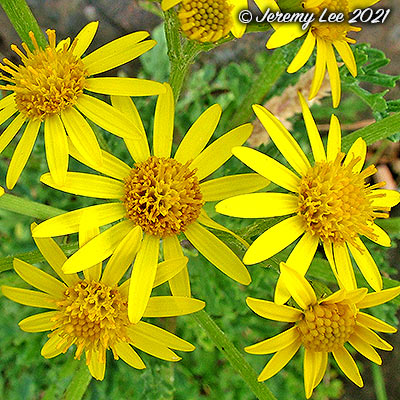
 |
|
Scientific Classifications explained » Amphibians » Ants » Aphids » Bees » Beetles » Birds » Bugs » Butterflies » Caterpillars » Damselflies » Dragonflies » Earwigs » Flies » Frog/Leafhoppers » Fungi » Galls » Grasshoppers » Harvestmen » Hoverflies » Lacewings » Ladybirds » Leaf Mines » Lichens » Mammals » Millipedes » Mosses » Moths » Sawflies » Slugs » Snails » Spiders » Trees & Shrubs » Wasps » Wild Flowers » Woodlice » Postboxes |
UK Nature > Wild Flowers > Yellow Wild Flowers > Senecio jacobaea

Scientific Name: Senecio jacobaea Common Name: Ragwort Senecio jacobaea, more commonly known as Ragwort, is a very common wild flower in the family Asteraceae, found usually in dry, open places. The plant is generally considered to be biennial but it has the tendency to exhibit perennial properties under certain cultural conditions (such as when subjected to repeated grazing or mowing). The stems are erect, straight, have no or few hairs, and reach a height of 0.3–2.0 metres. The leaves are pinnately lobed and the end lobe is blunt. The many common names that include the word "stinking" arise because of the unpleasant smell of the leaves. The flower heads are 1.5–2.5 centimetres in diameter, and are borne in dense, flat-topped clusters; the florets are bright yellow. It has a long flowering period lasting from June to November. Pollination is by a wide range of bees, flies and moths and butterflies. It is the preferred food plant of the strikingly-marked larvae of the Cinnabar Moth (Tyria jacobaeae). |
|

https://www.uknature.co.uk is a website dedicated to showing the immense diversity of UK nature and wildlife. Our vast range of habitats, from lowland arable to snow covered mountains, from storm-ravaged coastlines to peaceful inland freshwater lakes and rivers, from dry, sandy heaths to deciduous and coniferous forests, all these habitats contribute to the abundance of UK nature. We have wild birds in huge numbers either residing or visiting our shores (597 recorded species as at July 2013) and we must also not forget the humble back garden with its grass lawns, flower beds filled with nectar rich flowers, shrubs and trees, all designed to attract huge numbers of insects such as bees, moths, butterflies and hoverflies; and finally the small ponds which provide safe havens for frogs, toads, newts and even slow worms and grass snakes. www.uknature.co.uk is the showcase for my personal passion, photographing uknature in all its glory. I sincerely hope you all enjoy the fruits of my labours. This site and all images contained therein is © Jeremy Lee 2004 - 2025. All Rights Reserved. Site design by Jeremy Lee. Site development & IT Support by Stuart Lee. |